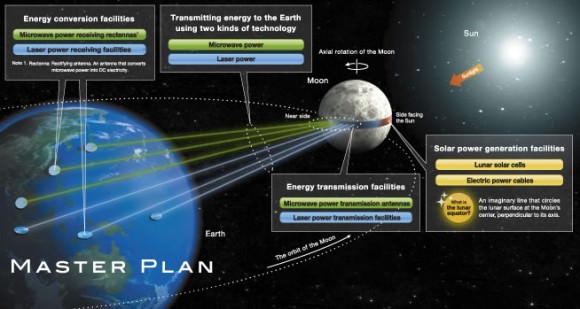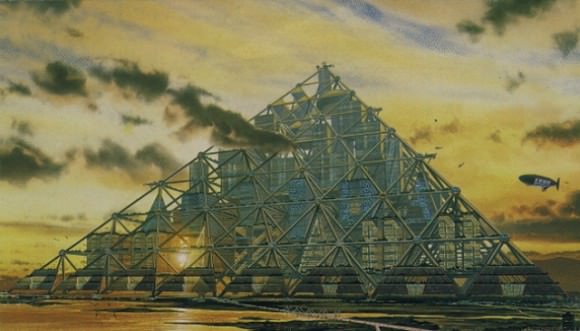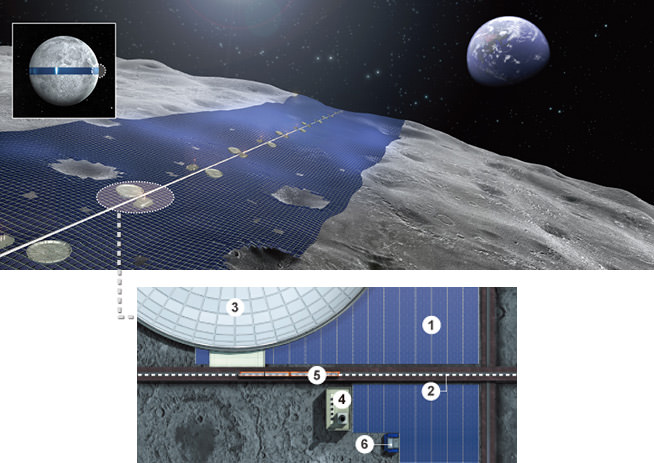[/caption]
Space based solar power? How about a Moon-based solar collector that would beam energy back to Earth. This is just one idea proposed by a 200-year-old Japanese construction company, Shimizu that prides itself in forward-thinking technology and structure development. For this “Luna Ring,” an array of solar cells would extend like a belt along the entire 11,000 km lunar equator, and laser power transmission facilities would beam a high-energy-density laser towards receiving stations on Earth.
See more on the Luna Ring, plus plans for orbiting hotels, Moon bases, mega-pyramid cities, and more, below.

For this structure to be successful, teams of astronauts would have to support robotic surface operation on site. So, they would need a lunar base. Shimizu has that design in mind, too.

Lunar bases could be constructed using concrete made from lunar regolith. Using a hexagonal shape would allow for multi-directional future extension of the structure. Unmanned construction systems will be a critical matter in the severe lunar environment. The concept of self-assembling structures using membranes and air-inflation systems could realize light-weight structures and reduce transportation costs. Shimizu is also developing construction robot technologies that could be applied to constructing a lunar base, minimizing the hazards of manned activities.

For long-term manned mission, the interior of base should be designed considering 1/6 G gravity environment.
The Shimizu Corporation says they have been accumulating technological skills over 200 years and would welcome the challenge of applying them to the new frontier of the moon, while continuing R&D on structures, materials, construction systems, and design of lunar bases.

Shimizu has this concept for a space hotel, which includes a space elevator, approximately 240 km long, for “easy” access from Earth (building a space elevator will not be easy), but visiting spacecraft could dock as well. This large complex structure would be composed of several modules, such as a lobby, restaurants, and an area for recreation.

Shimizu is also looking at how they could build incredible structures on Earth that would house people and buildings on the oceans. The Mega-City Pyramid is a self-contained city for one million people. The basic structure—an assembly of regular octahedral units composed of shafts made from lightweight materials such as carbon fiber would be a project of unprecedented scale and proportion.
This video provides a look at some of the potential problems and hurdles to overcome for this type of structure:

This “green” floating village would be almost like a giant lily pad floating on the water. Shimizu wants to create these cities that would act just like a lily, absorbing CO2 like a plant, as well as using other environmental technologies to achieve a carbon negative system. Solar power and resources from the ocean, as well as converting waste into energy would be used to give the floating city 100% self-sufficiency.
Visit the Shimizu website for more information about the company, and see their “dream” section for more information about these futuristic mega-projects.
Source: Shimizu, via Pink Tentacle


Microwave energy transfer technology used to give me the willies until they got the energy density down under solar irradiation energy levels. So I guess the added risk of longer angular baseline and support line here isn’t much of a concern anymore.
I’m more concerned with the idea of static build cities. Sure they are effective to build and inhabit, but it will be a bitch to maintain and develop. (“- Hey, build a new city in 20 years and tear the old one down.” “- Great idea, we will start at once!”)
Very neat.
What’s with the space shuttle?
That space station looks higher than 240km… and I thought a space elevator had to make it to geostationary orbit.
This sort of stuff makes for “wow cool” pictures, but I have to confess I am not sure they will come to fruition.
The lunar solar “ring” would collect a lot of energy. If I assume the width of it is 100km, then half of the 11,000 km circumference is illuminated. Further this is 1/sqrt{2} average the solar intensity of 1350w/m^2 do to a cosine from solar incidence. This would generate about 1.5e^{16} watts, which is about 1000 times the power we currently generate. That is a lot of power! Maybe in the future globally warmed Earth we will need that to run all the air conditioning required.
This sounds a bit like a celestial version of conspicuous consumption.
LC
US had those grandiose ideas about space based power generation system back in 60s and 70s. NASA did many studies for follow on after moon landing; large lunar base and all. We lost our way 30 years ago. I have see some of those lost archives!
“Maybe in the future globally warmed Earth we will need that to run all the air conditioning required.”
I hope there will be a people to cool when time comes. When world’s glacier melts, India and China will be gone; no water, no food. World population can easily fall by half. When arctic ice sheet melts, watch out. The warming will really go wild! By the way, half of ice sheet is gone to date during summer. Few years back, scientist were thinking it is going to take 50 years! They were way way way off the mark!
Am I the only one who doesn’t want some ugly blue band covering the moon? I could see the value of panels placed out of view on the out facing side of the moon.
It does create curiosity for when the time comes for areas of the moon to be developed what countries will make claim to what areas and what countries will disagree.
The problem with solar power satellites is energy costs to deploy them in space are huge. A gigawatt power station would have to be 740740.m^2 in area or over 850m on a side. Now if I assume that a square meter weight 1kg that is 741000kg or 741 metric tons. This is about the mass of 7 space shuttles. Now at geosynchronous orbit you have almost left the Earth’s gravitational potential, so for ease let me assume the velocity to send a mass there is escape velocity ~ 10km/s^2 or 10^4m/s^2. Then the energy E = 1.2mv^2 required to get there is about 7e^{13} joules. Now if we factor in the rocket equation it takes about 100 times the energy to loft the material out there. So we need about 10^{16} joules to install this. Of course these are ballpark figures, but sufficient for the sake of argument. Now if this is generating 10^9watts we can recover the energy itself in only 10^7 seconds (about a year). However, the cost of that energy is enormous. The launch and fabrication cost would be on the order of about $100-1000 billion, and if this energy is metered at $.1/kw-hr, or a dollar per 10hrs at 10^3w, and would require about 10^5 to 10^6 hours or 4170. to 41700 days (11 to 110 years) to recover the cost.
LC
JWarren: …what countries will make claim to what areas and what countries will disagree.
That is what wars are fought over. 🙁
LC
Cool stuff, but that super powerful lasers can easily become super weapons. And what about the high-energy beam – atmosphere interaction?
Bloody marvellous. These are the ideas we should be pursuing. Thank goodness someone is thinking along these lines. I still think that an equatorial belt maglev mass driver would be better. Ooops, I almost sounded like the usual naysayers with that last bit.
Whatever the blue-sky ratio of these ideas at least some sections of the human race are not in the thrall of their cost accountants and are looking to the long-term future. I am hoping that the problems that have to be solved for space based fabrication will lead to the kind of self-replicating, self repairing micro-manufacturing technology that we need to prosper in this century.
Sigh. Again with the space elevator. That is not going to happen ever. Technical difficulties aside who will accept the possibility of thousands of miles of razor sharp nearly indestructible cable over their heads? Nobody. After all if it got cut where would it go? And as far as beaming all that energy back from moon or space goes wouldn’t all that extra energy increase global temperatures? It is kind of a bad time for that.
The only really feasible idea there is the floating city. There is a lot of ocean.
I would expect this sort of ignorant thinking from an Earth-bound construction company. If they are so forward thinking, why not create large solar collectors in the Sahara and Siberia; while there use the energy in the area to improve it for human & animal habitation along with farming.
You don’t need to go to the moon to use solar energy. Might as well go to the Moon for milk and eggs. If you are going to get anything from the Moon, how about mining H3, and use the resources to build facilities on Earth to use it, and use your logistics to transport it.
All in all, this isn’t R&D, this information is pure fantasy. Could it get done?? …sure, but why build a robot to place a band-aid on a cut, when we can be more effective using our hands.
Emilio, I think that is it exactly, it is a moral problem on account of the projection of deaths, suffering and fighting poverty. IIRC UN claimed 10 % climate refugees ~ 2050, I don’t think it has changed.
Our species is evolving, has always been but is more so now with increasing population. The increased efficiency of selection picks up smaller positive and negative fitness “signals” from increased range of variation “noise” to fixate on. (Though there is a discussion if the measured massive selective sweeps actually don’t have time to fixate because the environment changes faster than gene-cultural evolution time constants.) So we will change but unlikely go extinct.
I don’t recommend it, but extinction statistics seems to say:
1) Modern mass extinctions, like the one we seem to observe happen today at current extinction rates, results in greater diversity after the recovery. (See for example Wikipedia’s graphs of same.)
2) Recovery period may be < 1 My. (There was some paper on that recently.)
So, given that ~ 0.1 – 1 My is the time constant for mammal species, we will certainly be different when the biosphere recover from prolonged AGW. (Say, from 1 or 2 centuries longer forcing, giving 1-2 millennium of AGW, more than enough time for a serious extinction of 1000s or 10 000s of species even at the current rate of ~ 1-10 species/y IIRC; unless the climate tips to a new state in which case we can count the AGW as "indefinitely long".)
But our new species we eventually will be, will have a more productive Earth; to demolish all over again. :-~ [Cue to Niven's and Pournelle's "The Mote in God's Eye", on species that are stuck in relentless rebuild-demolish cycles, and the dreamers of alternatives are "crazy Eddie's".]
I’m not so hot on the eventual possibilities myself, but I note that in the actual competition (latest at ~ 1 km height; awesome!) they use carbon fiber tape as everyone else. No cable, no razor, no sharpness.
Lawrence B. Crowell: “That is what wars are fought over.”
Those times are gone. Nowadays most things are negotiated.
I am with Aodhhan on this one. I remember a study about 10 years ago that utilized self replication technology to build a very large, 20 GW solar power facility in the US’s south west desert areas. I would imgine the cost would be many times lower and would make use of exisitng infrastructure already planned for a smart grid, decentralized power generation scheme.
Aodhhan said;
“I would expect this sort of ignorant thinking…”
From you I’d expect nothing better!
As for;
“…this information is pure fantasy”
As is anything you usually comment on….
I like the idea of von Neumann machines and think it’s something that should be given a lot of serious thought. However, Fred Sabrehagen’s ‘Berserkers’ do spring to mind!
Solar power satellites are not complete bunk. The problem is mass. They clearly could not be fabricated with silicon wafers. There are interesting developments with graphene, which is a monoatomic two dimensional layer of carbon. Two layers of these which are P and N doped could serve as a solar cell, and a lamination of these layers could serve as solar PV cells. In my estimate I assumed 1 Kg per meter squared. With this sort of system that might be reduced to 1gram per square meter. Now the solar panel would be a sort of kite tethered to a mass with station keeping ion engines at some distance away. The PV kite plus mass would be gravity gradient stabilized and could have a mass of a few metric tons. If this sort of system could be developed then solar power satellites would be “cooking with gas,” so should we say the sun.
The advantage to solar power satellites is there is no atmospheric attenuation, no weather and the cells can be steered so they point to the sun with normal incidence all the time.
@ Duncan Ivry In recent times there has been an uptake in wars. The US is involved with two of them, and one of them was over oil — or to secure oil profits as Dick Cheney, Haliburton and the oil companies made out like bandits in the mid-late 2000’s. The Republicans are chomping at the bit to start another with Iran. Palin got a solid round of applause for suggesting such.
LC
By 2050 the climate problem might already be back on its course. The guy that created the first synthetic life has now some very cool possibilities of 4th generation fuel cells that could convert CO2 into fuel.
At first I thought he was not serious but apparently he might be very on track by the end of the year. He discovered cells that already can do this but needed to be improved 1000 times so they can re-engineer the cell and create synthetic life.
I think one day maybe we convert lunar soil or regular-sand into solar sells by just letting the synthetic generated cells eat the sand/soil.
I am continually amused by ideas of converting CO_2 to fuel, and related schemes. This is similar to the idea that water H_2O is a fuel. These simple chemicals are in the low energy form. You have to input energy into them to get them into a high energy form. A moment of reflection on thermodynamics should make this somewhat clear. Suppose you burn coal to convert CO_2 into fuel. You will have to burn more coal, thus producing more CO_2, than the fuel you get from converting a smaller amount of CO_2 into fuel. The whole idea is not thermodynamically possible.
As for synthetic life converting SiO into silicon crystals, that is pretty wild speculation at this point. Silicon does not enter much into biology. Silicon does not readily exist in polymer form. Silicone, a polymer of Si and O, exists with the help of some creative chemical engineering.
LC
it’s good to dream…